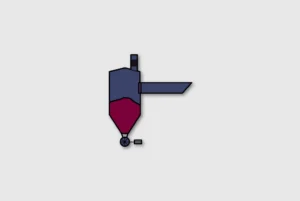Hazard and Operability (HAZOP) Studies are a systematic and structured process hazard analysis (PHA) methodology that is used to identify potential workplace hazards and operability issues in a facility, system, or process. In essence, a HAZOP is primarily used to examine the individual components and operations of a system to identify deviations from the intended design.
As a single individual cannot grasp the complexities of an entire process, a diverse and knowledgeable set of HAZOP team members, led by an experienced facilitator/chair/leader (we will use facilitator for ease of use throughout this blog) is key to the success of the study and the plant/process moving forward.
The team should therefore consist of a facilitator, design engineering, test engineering, safety experts, maintenance personnel, and operational experts. The mixture of technical expertise ensures that a holistic study is undertaken, and that no aspect of a particular process remains unexamined.
The focus for this short blog is the team members and the role of the facilitator in ensuring that the HAZOP runs as efficiently (time, cost, and technical output) as possible. We discuss how these technical experts should prepare and the influence they have when contributing to the creation of HAZOP information, nodes, and parameters.
Who makes up a HAZOP Team?
The HAZOP team should consist of experts from various disciplines, including engineering, operations, maintenance, and process safety. Below is a short list containing core members of the team and a short description of what they can bring to a HAZOP study both during and in preparation.
1. Process Engineers:
- Review process design documentation to identify areas of complexity and/or potential hazards.
- Prepare process flow diagrams and Process and Instrumentation Diagrams (P&IDs).
- Provide technical history & general expertise on process and control operations.
2. Process Safety Engineers:
- Conduct preliminary hazard assessments to identify high-risk operations and zones.
- Review relevant safety procedures.
- Provide guidance on risk assessment criteria and mitigation strategies.
3. Operators:
- Prepare and share insights into daily operations and previous incidents or near misses.
- Identify operational challenges or deviations from standard procedures.
- Provide input on equipment reliability and maintainability.
4. Maintenance:
- Identify equipment maintenance requirements and historical failure data.
- Highlight any recurring maintenance issues or known failure modes.
- Provide input on the reliability and integrity of equipment and instrumentation.
5. Instrumentation and Control Engineers:
- Review control system design and instrumentation diagrams.
- Identify potential failures in instrumentation and control loops.
- Provide expertise on process control strategies and Safety Instrumented Systems (SIS).
6. Environmental Health & Safety Specialists:
- Assess environmental impacts of operations.
- Identify environmental regulatory requirements and compliance issues related to emissions, effluents, and waste.
- Provide input on environmental risk management and mitigation.
7. Quality Assurance/Control:
- Review equipment and material quality management procedures and documentation.
- Identify potential quality control issues.
- Provide expertise on quality assurance practices and standards.
8. Project Managers:
- Coordinate and schedule for study session.
- Ensure that relevant stakeholders are engaged and informed.
- Monitor progress against established timelines and objectives.
9. Subject Matter Experts (as needed – a few examples are given above):
- Provide specialized technical knowledge or insights related to specific aspects of the process or equipment.
- Assist in identifying and evaluating potential hazards or failure modes in their area of expertise.
- Offer guidance on best practices and industry standards applicable to the systems under study.
Each member of the team will research, plan, and bring their own specialist knowledge, the breadth of information collected before the HAZOP begins is testament to how complex the study can become. Although the entire team should be trained in the HAZOP methodology and must have a clear understanding of the system or process being studied, without clear guidance the result won’t be concise enough to make actionable items from.
The Role of HAZOP Chairs & Scribes
Guiding the HAZOP study is the facilitator. The facilitator must be a seasoned professional trained in the HAZOP methodology as they take charge of the study by directing the discussion (meaningful conversations that identify potential hazards and deviations) towards a pragmatic end.
The HAZOP scribe, on the other hand, is responsible for recording the dialogue and outcomes. In larger studies, where the volume of information can be far more complex and substantial, a dedicated scribe will be required. For smaller HAZOP studies, the facilitator can take on the role of the scribe.
HAZOP Information & Documentation
Before undertaking a successful HAZOP, relevant process safety information must be collected by individual members of the team.
Examples of relevant documentation include:
- Process flow diagrams.
- P&ID’s.
- Plant layouts.
- Relevant Material Safety Data Sheets (MSDS) (to understand potential domino effects),
- Heat and material balances.
- Equipment data sheets
- Cause-and-effect diagrams (including automated or semi-automated safeguards)
- Descriptions/insights of process and operation sequences (steps involved in normal operations, startups and shutdowns, and emergency procedures)
This detailed documentation ensures that there is comprehensive process data and information behind the HAZOP to ensure that the facilitator can effectively guide those undertaking the study to the potential issues.
Where the documentation listed above is missing or lacking detail, the study will suffer. How much so will range from a complete inability to complete an effective study to additional actions to clarify or to confirm. In either event, this will increase costs, time and resources. An experienced facilitator will go through the provided information prior to the workshops to establish whether this is likely and can proactively advise the client of any gaps and their likely influence.
HAZOP Nodes
Nodes effectively split processes into bite size elements that allow members of the HAZOP team to identify potential risk at a microscopic level.
Nodes can be system-based, process-based, or dependent on an individual process.
In an LNG peak shaving facility, for example, a node could be attributed to a specific operational event. The transfer of liquefied natural gas (LNG) from a truck to a bunkering tank, for example, would be one node. The tank, with its pressure safety valves (PSVs) and instrumentation, would also be a node. Outlet pumps, vaporisers and compressors would each be a separate node.
The nodes must cover all relevant aspects of a process, team members should consider the likelihood and consequences of deviations of each node to prioritise further analysis. For example, a process engineer might highlight a critical process parameter that could lead to a deviation, while an operator might have an alternative insight into the critical control points of that same operation.
By segmenting complex processes into manageable nodes, specific operational sections can then be focused on. Again, the breadth and complexity of the information indicates the complexity of the study, especially when the outcome is the protection of your business, people, workplace, and the environment.
Visual Mapping: Nodes and Parameters
At the start of a HAZOP study session, a canvas is laid out with project equipment drawings. These drawings provide a visual map of the process/plant and will guide both the facilitator and the team to the root cause of a potential hazard.
Parameters such as pressure, temperature, and level are then chosen for evaluation. The guide word, whether it’s ‘more,’ ‘less,’ ‘no,’ or ‘reverse,’ sets the stage for investigating potential deviations within the selected parameter.
Deviations are then discussed by the team to establish whether there is an identifiable cause and, if there is, what the worst-case consequences might be. Consider a malfunctioning flow transmitter for raw material A. The team identifies and discusses the potential consequences of this hazard. It may, for example, simply look at the journey accumulation of material A to catastrophic events like a runaway reaction or reactor rupture.
With each completed parameter, the team assesses whether additional potential deviations or guide words exist. The iterative process continues, probing other parameters within the node.
An experienced facilitator must be well placed to define node boundaries. They must be small enough such that they are not unwieldy and yet not so small that the study is artificially long. A typical node may take 2 to 3 hours to analyse and there may be temptation to combine nodes to reduce time and effort. The facilitator must, therefore, ensure that there is no loss of effectiveness and rigour.
A standard list of parameters will always be considered; flow, temperature, pressure etc, but other parameters may well be useful depending on the nature of the process. For example, Wobbe Number is frequently useful to consider in gas and energy processes. In waste treatment, odour may be a significant and in food processing the presence of vermin, leading to one memorable HAZOP when the deviation ‘Rats-More’, was a genuine scenario. Having a facilitator with wide experience across the process industries will help to reduce the chances that these less common concerns will be missed.
How can you create a successful HAZOP study?
After undertaking a successful Hazard and Operability study, specific scenarios are generated and then prioritised by risk. With a selection of safety, prevention, control, and mitigation measures recorded, outputs can then be used to analyse multiple scenarios before the potential use of any further studies.
As a single individual cannot grasp the complexities of an entire process, a diverse and knowledgeable set of HAZOP team members, led by an experienced independent facilitator is key to the success of your study.
Sigma-HSE have facilitated various HAZOP studies and have led the way in providing actionable insights for industry experts to ensure timely responses to potential hazards. Our facilitators have also ensured that business around the world have saved time and monetary resources by providing necessary adjustments to their project by eliminating the possibility of associated risk in later design stages.



